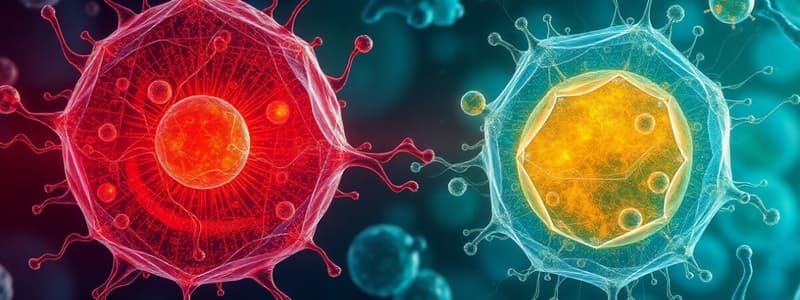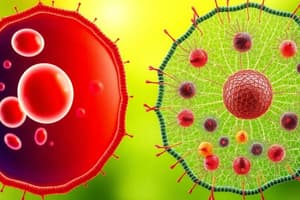Podcast
Questions and Answers
Which of the following are types of muscle tissues? Select all that apply.
Which of the following are types of muscle tissues? Select all that apply.
- Cardiac muscle (correct)
- Skeletal muscle (correct)
- Smooth muscle (correct)
- Epithelial muscle
The main functions of the nervous system include only controlling voluntary actions.
The main functions of the nervous system include only controlling voluntary actions.
False (B)
What is cancer?
What is cancer?
Cancer is a disease characterized by the uncontrolled growth and spread of abnormal cells in the body.
The connective tissue that connects muscles to bones is called a ______.
The connective tissue that connects muscles to bones is called a ______.
Match the following organs with their respective body systems:
Match the following organs with their respective body systems:
Which of the following is NOT one of the three postulates of the Cell Theory?
Which of the following is NOT one of the three postulates of the Cell Theory?
Eukaryotic cells do not have a defined nucleus.
Eukaryotic cells do not have a defined nucleus.
What is the main function of mitochondria in a cell?
What is the main function of mitochondria in a cell?
In plant cells, the organelle responsible for photosynthesis is the __________.
In plant cells, the organelle responsible for photosynthesis is the __________.
Match the following organs of the digestive system with their functions:
Match the following organs of the digestive system with their functions:
Which type of tissue is responsible for contraction and movement in animals?
Which type of tissue is responsible for contraction and movement in animals?
Cytokinesis is the process of DNA replication in a cell.
Cytokinesis is the process of DNA replication in a cell.
What are the three main reasons why cells must divide?
What are the three main reasons why cells must divide?
Flashcards
Cell Theory Postulates
Cell Theory Postulates
All living things are composed of cells, cells are the basic unit of structure and function in living things, and all cells come from pre-existing cells.
Prokaryotic vs. Eukaryotic Cells
Prokaryotic vs. Eukaryotic Cells
Prokaryotic cells lack a nucleus and membrane-bound organelles, while eukaryotic cells have both.
Animal vs. Plant Cells
Animal vs. Plant Cells
Animal cells lack a cell wall and chloroplasts, whereas plant cells have both.
Cell Division Reasons
Cell Division Reasons
Signup and view all the flashcards
Digestive System Organs
Digestive System Organs
Signup and view all the flashcards
Mechanical vs. Chemical Digestion
Mechanical vs. Chemical Digestion
Signup and view all the flashcards
Blood Vessels
Blood Vessels
Signup and view all the flashcards
Blood Cells
Blood Cells
Signup and view all the flashcards
Musculoskeletal system function
Musculoskeletal system function
Signup and view all the flashcards
Skeletal muscle function
Skeletal muscle function
Signup and view all the flashcards
Cancer definition
Cancer definition
Signup and view all the flashcards
Nervous system main function
Nervous system main function
Signup and view all the flashcards
Benign tumor characteristics
Benign tumor characteristics
Signup and view all the flashcards
Study Notes
Cell Theory Postulates
- All living organisms are composed of cells.
- Cells are the basic units of structure and function in living organisms.
- Cells arise from pre-existing cells.
Prokaryotic vs. Eukaryotic Cells
- Prokaryotic cells lack a nucleus and membrane-bound organelles.
- Eukaryotic cells have a nucleus and membrane-bound organelles.
Animal vs. Plant Cells
- Plant cells have cell walls, chloroplasts, and a large central vacuole.
- Animal cells lack cell walls, chloroplasts, and a large central vacuole.
Cell Organelles and Functions (table)
| Organelle | Function | Animal Cell? | Plant Cell? |
|---|---|---|---|
| Cell Wall | Provides structural support | No | Yes |
| Cell Membrane | Regulates what enters and leaves the cell | Yes | Yes |
| Mitochondria | Site of cellular respiration | Yes | Yes |
| Ribosomes | Site of protein synthesis | Yes | Yes |
| Chloroplast | Site of photosynthesis | No | Yes |
| Nucleus | Contains DNA | Yes | Yes |
| Nucleolus | Found within the nucleus; involved in ribosome production | Yes | Yes |
| Centrioles | Involved in cell division | Yes | No |
| Endoplasmic Reticulum | Involved in protein and lipid synthesis | Yes | Yes |
| Golgi Bodies | Processes and packages proteins and lipids | Yes | Yes |
| Vacuole | Stores water and other substances | Yes | Yes (large central vacuole in plants) |
| Lysosome | Contains enzymes that break down waste | Yes | Yes |
Reasons for Cell Division
- Growth
- Repair
- Reproduction
Stages of the Cell Cycle
- Stages and description depend on the specific context of the prompt (mitosis, cytokinesis). Note diagrams are also provided for visual aid
Cytokinesis Differences
- Animal cells: Cytoplasm divides by a cleavage furrow.
- Plant cells: Cytoplasm divides by a cell plate.
Hierarchy of Life
- Cells → Tissues → Organs → Organ Systems → Organisms
Animal Tissues
- Epithelial tissue: Covers and lines body surfaces.
- Connective tissue: Supports and connects body parts.
- Muscle tissue: Enables movement.
- Nervous tissue: Transmits nerve impulses.
Digestive System Organs and Functions (table)
| Organ | Description of Function |
|---|---|
| Mouth | Mechanical digestion, beginning of chemical digestion |
| Salivary Glands | Produce saliva, containing enzymes |
| Esophagus | Transports food from mouth to stomach |
| Stomach | Mechanical and chemical digestion of food |
| Small Intestine | Absorption of nutrients |
| Large Intestine | Absorption of water, elimination of waste |
| Rectum and Anus | Elimination of feces |
| Liver | Produces bile, filtering blood |
| Gall Bladder | Stores bile |
| Pancreas | Produces enzymes for digestion, hormones for regulating blood sugar |
Blood Vessels
| Blood Vessel Type | Structure | Function |
|---|---|---|
| Arteries | Thick, elastic walls | Carry oxygenated blood away from the heart |
| Veins | Thin walls, valves | Carry deoxygenated blood back to the heart |
| Capillaries | Thin walls, single layer of cells | Exchange of substances between blood and tissues |
Blood Cell Types
| Blood Cell Type | Structure | Function |
|---|---|---|
| Red Blood Cells | Biconcave discs, no nucleus | Carry oxygen |
| White Blood Cells | Various shapes, nuclei | Fight infection |
| Platelets | Cell fragments | Involved in blood clotting |
Respiratory System Parts and Functions (table)
| Organ/Structure | Description of Function |
|---|---|
| Nose/Mouth | Intake of air |
| Pharynx | Passageway for air and food |
| Larynx | Voice box; contains vocal cords |
| Trachea | Windpipe, passageway for air |
| Bronchi | Branch into smaller tubes |
| Bronchioles | Smaller tubes leading to alveoli |
| Alveoli | Tiny air sacs where gas exchange occurs |
| Diaphragm | Muscle that aids in breathing |
Musculoskeletal System Role
- Provides support, protection, and movement.
Muscle Tissue Types & Functions
| Muscle Tissue Type | Description of Function |
|---|---|
| Skeletal Muscle | Voluntary movement |
| Cardiac Muscle | Involuntary heart contractions |
| Smooth Muscle | Involuntary movement of internal organs |
Connective Tissues and Functions
| Connective Tissue Type | Description of Function |
|---|---|
| Bone | Support and protection |
| Cartilage | Cushioning and support |
| Tendons | Connect muscles to bones |
| Ligaments | Connect bones to bones |
Nervous System Functions and Divisions
- Functions: Control bodily functions, sensory input, communication throughout the body.
- Two divisions: Central Nervous System (brain and spinal cord); Peripheral Nervous System (nerves branching out).
Cancer Terminology (general)
-
Benign tumor: Non-cancerous growth
-
Malignant tumor: Cancerous growth
-
Metastasis: Spread of cancer cells
(additional details on cancer detection and treatment methods are required under the request specifications).
Human Human Organs and Body Systems Table (partial)
| Organ | Body System |
|---|---|
| Spinal cord | Nervous System |
| Heart | Circulatory System |
| Bladder | Urinary System |
| Pancreas | Endocrine / Digestive System |
| Brain | Nervous System |
| Stomach | Digestive System |
| Kidneys | Urinary System |
| Esophagus | Digestive System |
| Liver | Digestive System |
| Trachea | Respiratory System |
| Intestines | Digestive System |
| Lungs | Respiratory System |
(Other organs and body systems are omitted as further detail would be required. The structure of the table in the OCR is partial; complete data not provided).
Studying That Suits You
Use AI to generate personalized quizzes and flashcards to suit your learning preferences.




